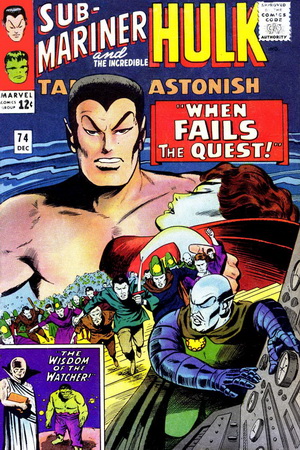
Published: December, 1965
Script: Stan Lee
Pencils: Adam Austin
Inks: Vince Colletta
Letters: Sam Rosen
“The Wisdom of the Watcher!”
Script: Stan Lee
Layouts: Jack Kirby
Pencils: Bob Powell
Inks: Mickey Demeo
Letters: Sam Rosen
What defines a hero? What defines a villain? The December 1965 issue of Tales to Astonish begins in a very classic, traditional manner, adhering to the prescribed formula of most Marvel comics up till this time. Both of these particular tales are installments of stories that have been going on for several issues now, so we know what we’re getting—and we begin with another episode of an adventure story of ancient royalty beneath the sea. In twelve quick pages, the plot easily advances with large dramatic panels.
SUB MARINER
This is a classic tale of good and evil. The heroes and villains are clearly depicted. There’s no doubt who you’re supposed to root for. Namor, of course, is our hero, and at every moment he acts like a hero, always trying to do what is right, not merely for himself, but primarily for his kingdom. He is a king who is willing to make sacrifices in order to accomplish what is best for the greater good.

He has to make tough choices. Though it’s taken him a little time, he finally decides he must try to save Dorma, his most loyal and devoted subject (and maybe more??) from the dreaded Faceless Ones. I’m glad to see that at last he is showing her proper appreciation, that this business of Loyalty is not simply a one-way street for him.
At other times, when Namor comes to the surface world, he may appear more villain than hero, as his agenda clashes with that of the human race, but in this story, which takes place entirely on his own turf, there is no doubt that he is the hero.
KRANG
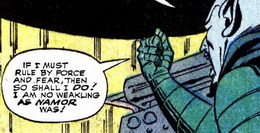 Krang, on the other hand, is the most dreadful of villains. He is so bent on his evil plans that once he realizes the citizens of Atlantis have turned against him, he becomes more dangerous than ever, digging in his heels and willing to do anything he can to preserve his power and position. In fact, he is gleefully hell-bent on “plunging the entire planet into the greatest holocaust of all time!” Unless he’s using an entirely different definition for “entire,” that would necessarily include all of Atlantis. So: he is willing to destroy even the kingdom he is fighting so hard to rule, if only he can say, “Ha ha! I won!”? Isn’t that…counterproductive? Isn’t that—let’s be frank—a bit insane?
Krang, on the other hand, is the most dreadful of villains. He is so bent on his evil plans that once he realizes the citizens of Atlantis have turned against him, he becomes more dangerous than ever, digging in his heels and willing to do anything he can to preserve his power and position. In fact, he is gleefully hell-bent on “plunging the entire planet into the greatest holocaust of all time!” Unless he’s using an entirely different definition for “entire,” that would necessarily include all of Atlantis. So: he is willing to destroy even the kingdom he is fighting so hard to rule, if only he can say, “Ha ha! I won!”? Isn’t that…counterproductive? Isn’t that—let’s be frank—a bit insane?
THE FACELESS ONES
The Faceless Ones are also bad news, but not in the same way. Because they are faceless and so numerous, and seem driven by instinct, we don’t really despise them as much as we despise the evil Krang. We don’t know their inner thoughts, we don’t know what motivates them. They seem less human than many other villains a hero might face, perhaps more akin to an attacking pack of wild wolves, or swarming bees. Faceless Ones gotta do what Faceless Ones gotta do. It’s really nothing personal…it’s in their DNA.
But this all works. The story holds together, giving us exactly what we expect.
 HULK
HULK
And then I get to the Hulk story, where I start to realize that something different is going on. And has been going on for quite some time. The very fact that we have a Hulk at all is already breaking the classic construct of Heroes and Villains. Because, what is Hulk, after all? He can’t easily be defined. Sure, he’s crude and violent, but that alone does not make him a villain. And yet he has none of the niceties of your classic Hero. He doesn’t seem concerned with justice, or “putting things right”—at least not for the world at large. He doesn’t care about society. He just wants to be left alone.
From the beginning, it’s seemed the creators have never really known what to do with Hulk. They try one thing, then another; his powers and his motivations keep shifting. Recently Hulk and Banner have bonded, resulting in a more articulate character, but he remains a peculiarity in the Marvel Universe.
So while Namor is either hero or villain, depending on the geography of the story, Hulk is neither hero nor villain, no matter where we find him.
He’s the one who kicks the villain’s ass. He does heroic feats, but not for heroic purposes. His motivations are not heroic. As I’ve said, and as Hulk himself has said multiple times, he simply wants to be left alone. But because he accomplishes what the reader wants to see—villains getting their asses kicked—we tend to consider him more of a hero.
In this story, while the Leader is clearly a villain, all the other characters are neither hero nor villain, just existing in the nebulous in-between.
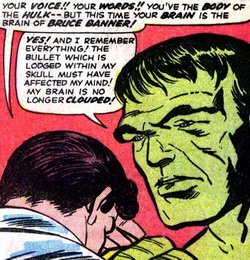 Hulk hates the Leader, but feels beholden to him, because the Leader saved his life. This shows an understanding and adherence to a certain heroic level of honor. But Hulk has only developed this sense of honor after he and Banner “merged.”
Hulk hates the Leader, but feels beholden to him, because the Leader saved his life. This shows an understanding and adherence to a certain heroic level of honor. But Hulk has only developed this sense of honor after he and Banner “merged.”
Do we “like” Hulk, or not? He’s not very likeable, so mostly, I just feel for him, or pity him. He’s been dealt a tough hand, not of his own making, and is obviously not very happy.
BIG RED LIZARD
In this story, we have the threat of an unnamed menace whom I will name the Big Red Lizard. BRL is not a “villain,” he is merely an opponent, a stumbling block in Hulk’s way, temporarily preventing him from accomplishing what he has set out to do: secure the Sphere and bring it back to the Leader, so he no longer has to be beholden. (Remember, it’s his sense of honor that makes him feel beholden.)
THE WATCHER
But now, we come to The Watcher. And here’s where things get really complicated. The Watcher claims to be someone who merely “watches,” who, if this is the case, would be neither hero nor villain. Yet in reality, he does so much more than simply “watch.” He says one thing, then does another. Way too often, we find him creating loopholes, then jumping through them. In reality, he is much more of a manipulator than a Watcher.
The Watcher has explained to us multiple times that he cannot interfere, yet when Hulk discovers he can understand the Big Red Lizard, he surmises, “The Watcher must have done something to let us understand each other’s language!” The story never explicitly says that’s what happened, but based on what comes next, it makes sense.
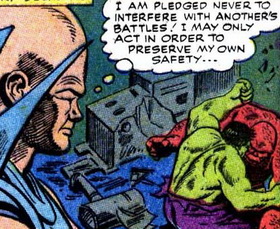 The Watcher states, “I am pledged to NEVER interfere with another’s battles. I may only act to preserve my own safety.” Yet, immediately after this proclamation, he determines that if Big Green and Big Red keep fighting, they will smash his scientific devices, which would curtail his own powers. And so he sends them to another location. Newsflash, Watcher! Protecting yourself and protecting your toys are not exactly the same thing.
The Watcher states, “I am pledged to NEVER interfere with another’s battles. I may only act to preserve my own safety.” Yet, immediately after this proclamation, he determines that if Big Green and Big Red keep fighting, they will smash his scientific devices, which would curtail his own powers. And so he sends them to another location. Newsflash, Watcher! Protecting yourself and protecting your toys are not exactly the same thing.
But I also take exception to the word “never.” He uses this word, then immediately does the very thing he just said he would never do. Just like Krang, he is redefining words on his own, making it up as he goes along. I have NEVER before heard this definition of the word “never,” but it reminds me of those Subway promotions where ANY sandwich is on sale…until you look at the small print on the bottom, where they list all the exceptions to “any.”

The Watcher interferes again by taking the liberty of sending the Big Red Lizard back to his own planet, because he, the Watcher, has determined that the battle has ended. But who is he, to determine that? How many times do you think your opponent is done for, and you turn your back for one moment and—BAM! There he is again. Unless the Lizard was certifiably dead, it was nobody’s call to say the fight had ended—especially not that of the “non-interfering” Watcher!
So in this story, the Watcher has determined when the battle begins, where it takes place, and when it ends. All while claiming non-inteference.
What makes him such a baffling fellow? What is his backstory?
Here’s the synopsis Russ wrote for the Watcher story in Tales of Suspense #53 (yes, Russ writes the synopses for the Meanwhile… posts):
The Watcher tells the story of how his utopian society, long ago, shared the secrets of nuclear energy with their neighboring planet, Prosilicus. The Prosilicans used that power to create unbeatable weapons to destroy their enemies, and eventually, they destroyed themselves. Devastated by these unintended consequences, the powers-that-be on the Watcher’s planet vowed that from that day forward they would no longer interfere with other planets. They would only…watch…
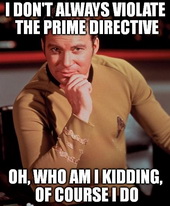 With all that in mind, I have to wonder…is he rebelling? He’s constantly justifying and rationalizing why he breaks the rules. They are not actually his rules, but rather the rules of his society, his race. I don’t see the Watcher as a hero. His very job description insists he is neither hero nor villain. He’s just the Watcher. From such a neutral position, I should probably neither like nor dislike him, but honestly, he’s starting to get on my nerves.
With all that in mind, I have to wonder…is he rebelling? He’s constantly justifying and rationalizing why he breaks the rules. They are not actually his rules, but rather the rules of his society, his race. I don’t see the Watcher as a hero. His very job description insists he is neither hero nor villain. He’s just the Watcher. From such a neutral position, I should probably neither like nor dislike him, but honestly, he’s starting to get on my nerves.
After reading this issue and contemplating questions about what defines a hero, or villain, or anyone “in between,” I realize that even in these early days of Marvel Comics, the answers are rarely clear-cut. The definition of a hero or a villain isn’t as two-dimensional as we might expect; indeed, it’s as open to interpretation as Krang’s use of the word “entire,” or the Watcher’s definition of “never.” Fortunately, as colorful as we find the artwork on each page of each Marvel comic, that’s how far from black-and-white these stories are.
And that’s what makes for good storytelling.
| Want to read this comic on your computer? Marvel has a scan! Want to own the Sub-Mariner story? Buy the Masterworks! Want to own the Hulk story? Buy the Masterworks! |














